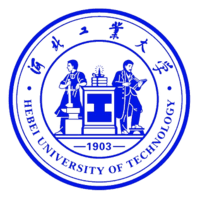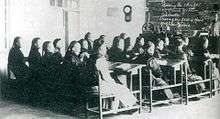Hebei University of Technology
 | |
| Motto | 勇毅专精 勤慎公忠 |
|---|---|
| Type | Public |
| Established | 1903 |
| President | Prof. Zhan Yong (展永) |
Academic staff | 2,100 |
| Undergraduates | 17,300 |
| Postgraduates | 3,200 |
| Location | Tianjin, China |
| Campus | Urban |
| Website |
http://www.hebut.edu.cn/ (中文) http://eweb.hebut.edu.cn/ (English) |
 | |
Hebei University of Technology (HEBUT; simplified Chinese: 河北工业大学; traditional Chinese: 河北工業大學; pinyin: Héběi Gōngyè Dàxué) is a public university whose main campus lies in the Guangrong Dao neighborhood of the Hongqiao District in Tianjin, China. It is the first institute of technology in modern Chinese education history. It is among the first group of institutions of higher learning in the national “211-Project” to which priority is given in funding.
History

The institution was established by Yuan Shikai, receiving a royal charter in 1903 as Peiyang Technological School, from Guangxu Emperor. Zhou Xuexi was the first president (Chinese: 总办).[1] The university modeled itself on the famous European and American institutions of higher learning and aimed to rejuvenate China by training qualified personnel with new scientific and technological knowledge. In 1958, after restructuring, institution was renamed Hebei institution of Technology. In 1995, institution was renamed Hebei University of Technology.
Timeline
1903–1949
1903: Founded with the name Beiyang Technical School
1904: Renamed as Zhili Higher School of Technology
1929: Renamed as Hebei Provincial Technological Institute
1946: Renamed as Hebei Provincial Institute of Technology
1949–1993
1950: Renamed as Hebei Institute of Technology
1951: Merged with Beiyang University as Tianjin University
1958: Re-established as Hebei Institute of Technology
1962: Integrated with Tianjin Mechanical and Electrical Engineering Institute, Tianjin Institute of Chemical Technology as well as Tianjin Construction and Engineering Institute into Tianjin Institute of Technology, Hebei Province.
1971: Restored with the name Hebei Institute of Technology
1994–present
1995: Renamed Hebei University of Technology.
1996: Enlisted as one of the first key universities in the national“Project 211" (which grants certain universities special funding). Successfully completed the three stages of construction.
The school has seen a breathtaking pace of development and the comprehensive educational strength has improved significantly.[2]
Notable people
Alumni
- revolutionary forerunner, Huang Ai
- chairman of the People's Political Consultative Conference of China, Jia Qinglin
- core staff the Boeing, Yang Minghui
Faculty
- nuclear scientist, Jiang Shengjie
- mechanic expert, Pan Chengxiao
- artist and art teacher, Li Shutong
General information
Hebei University of Technology (HEBUT) is a key provincial university as well as one of the national universities under "Project 211". It is also an important university under the authority of Hebei province which specializes in engineering studies and combines multiple academic areas including technology, science, economics, management and arts . It was founded in 1903, and was originally known as Beiyang Technical School. Since its establishment, HEBUT has always adhered to the motto “Diligence, Prudence, Devotion and Loyalty” to coach students and conduct research, and has gradually developed a distinctive school-running characteristic in which academic learning and engineering practice are equally stressed. HEBUT has 69 undergraduate programs, embracing a wide range of disciplines including engineering, science, economics, management, art and law. It is composed of 17 schools/departments, 1 physical-training teaching department and 2 teaching administrative schools. It has 6 state-level disciplines with specific characteristics and 18 province-level representative programs, 2 national key disciplines, 4 province-level advantageous disciplines and 20 provincial key disciplines. There are 42 disciplines authorized to award doctor degrees, 131 disciplines authorized to offer master's degrees or professional degree fields. HEBUT is the first engineering-based university to launch MBA program in China. Meanwhile, it is the only university in Hebei province that offers an EMBA education. It possesses 9 post doctoral work stations, among which “Material Science and Engineering” is special national program.
HEBUT owns 2474 qualified faculty members. Among 1365 full-time teachers, 706 hold senior professional titles, and 682 have doctorate degrees. With a “Long River” scholar and a “1000 Plan” professor, HEBUT further ensures that HEBUT students receive optimal instruction in their chosen field. There is an outstanding team of national technology expertise, 3 state-level teaching teams, 2 innovative research teams with the Ministry of Education, a state-level top teacher as well as 5 provincial teaching teams. 187 staff members won provincial and ministerial level honors, including the “National Middle-aged and Young Experts with Outstanding Contributions”, and national candidates in the “New Century Talents Project”. Hundreds of staff members hold posts of chairman, vice-chairman and secretary-general in professional societies or associations at or above provincial level.
HEBUT is equipped with 1 national engineering research center and 17 provincial and ministerial level research institutes, including 1 state key laboratory base co-founded by Hebei province and the Ministry of Science and Technology and the Engineering Research Center of the Ministry of Education. With the establishment of the HEBUT National Defense Science and Technology Institute, the university obtained a national military-industrial confidentiality qualification. Since 2004, near 3000 research projects have been undertaken resulting in 1500 scientific achievements (160 of which are national key level projects) which have been applied in many enterprises and public institutions. The National 02 Major Specialized Project, hosted by HEBUT, has successfully completed the national evaluation. Hundreds of scientific achievements won national, provincial and ministerial awards. With over 480 patents authorized, HEBUT is rated as one of the 10 outstanding Invention and Innovation Institutions in China.
HEBUT is located in Tianjin. and also has campuses in Langfang city. HEBUT covers an area of more than 267 hectares with a construction group area of 870,000 square meters. In the 200-hectare Beichen campus, a 400,000-square-meter construction project has been completed and put into use where, at present, there are more than 21,000 full-time students, including 6,373 post-graduates. The City College which is sponsored by HEBUT has 16,000 students, with 16,000 more pursuing their vocational and bachelor's degrees through adult education. The school teaching and research equipment is worth 372 million RMB, and there are 1.88 million books in the school library. Apart from that, well-equipped stadiums, dormitories and canteens facilitate student campus life.
With an open mind, HEBUT has been committed to international cooperation and attaches importance to the development, quality improvement and brand building of educational exchanges. It was qualified by a Chinese government project to award international student scholarships. At present, HEBUT has generated international exchange programs with universities in more than 60 countries and regions including France, the United States, Germany, Russia, Italy, Australia, Great Britain, Japan. Hong Kong and Taiwan . Over 20 exchange programs are being carried out, which so far have received 500 international students for non-degree education and sent more than 800 students abroad.
The diligent, prudent, truth-seeking and enterprising school ethos has been cultivated with the joint efforts from both students and faculty members. Its nearly 200,000 graduates have made important contributions to economic and social development. [3]
References
- ↑ Ed. Chen Dedi (Chinese: 陈德第) (2004). Looking Back a Hundred Years (Chinese: 回眸百年). Harbin: Heilongjiang Renmin Chubanshe. ISBN 7-207-06225-7/K.714, pg 4
- ↑ http://eweb.hebut.edu.cn/abouthebut/historyofhebut/index.htm
- ↑ http://eweb.hebut.edu.cn